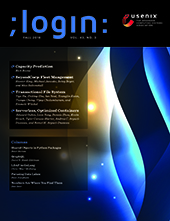
Capacity Engineering: An Interview with Rick Boone
;login: Enters a New Phase of Its Evolution
For over 20 years, ;login: has been a print magazine with a digital version; in the two decades previous, it was USENIX’s newsletter, UNIX News. Since its inception 45 years ago, it has served as a medium through which the USENIX community learns about useful tools, research, and events from one another. Beginning in 2021, ;login: will no longer be the formally published print magazine as we’ve known it most recently, but rather reimagined as a digital publication with increased opportunities for interactivity among authors and readers.
Since USENIX became an open access publisher of papers in 2008, ;login: has remained our only content behind a membership paywall. In keeping with our commitment to open access, all ;login: content will be open to everyone when we make this change. However, only USENIX members at the sustainer level or higher, as well as student members, will have exclusive access to the interactivity options. Rik Farrow, the current editor of the magazine, will continue to provide leadership for the overall content offered in ;login:, which will be released via our website on a regular basis throughout the year.
As we plan to launch this new format, we are forming an editorial committee of volunteers from throughout the USENIX community to curate content, meaning that this will be a formally peer-reviewed publication. This new model will increase opportunities for the community to contribute to ;login: and engage with its content. In addition to written articles, we are open to other ideas of what you might want to experience.

When I heard Rick Boone’s talk at SREcon18 Americas, I was immediately struck by his approach. While capacity planning is really an art, relying partially on past behavior but just as much on intuition, Rick described uncovering the best metric for reliably predicting capacity as needed.
Uber’s services run on their own hardware, and their goal is to always have sufficient capacity without ever having either too much or a shortage that will hurt business. Rick’s approach used machine learning to help pick out the appropriate metric and mathematically predict its impact on a service’s capacity needs. You can watch the video of his talk to learn the approach used. In this interview, Rick discusses why Uber doesn’t use capacity planning and instead relies on capacity engineering.
